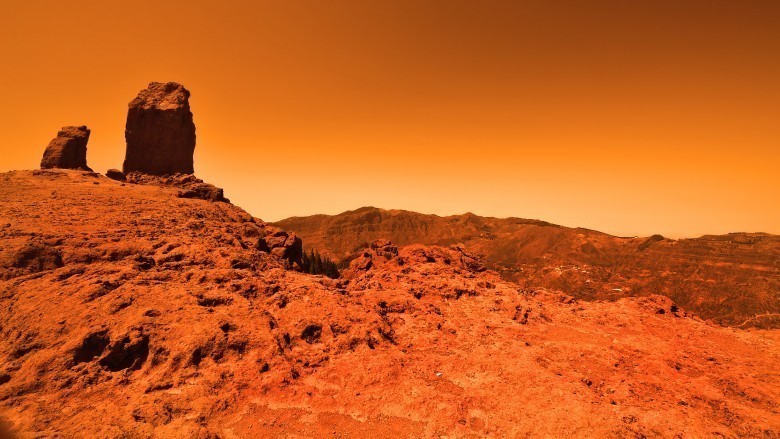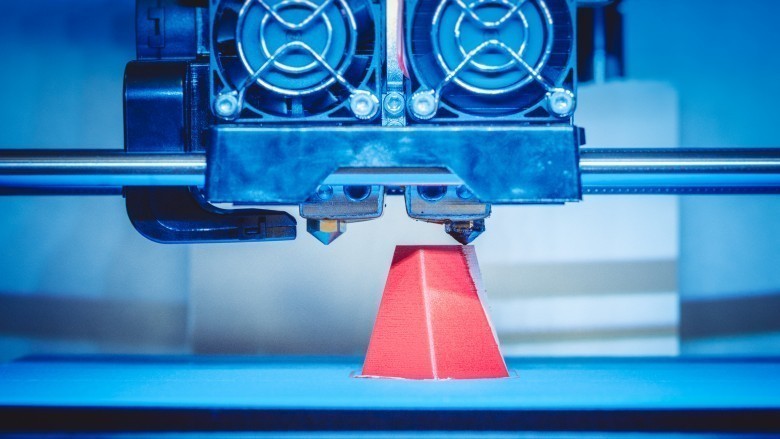The Most Insane Real Plans For Conquering Space
Writer, genius, and all around good guy Douglas Adams once said that "space is really big." In space, the room exists for humanity to stretch out its legs and reach our true potential. On a completely unrelated note, there's a lot of really valuable stuff up there that no one technically owns. With that being said, a lot of very smart and possibly insane individuals have some pretty unconventional ideas about the best way to go about getting their hands on all of those valuable resources that are just sitting up there ... waiting.
Japanese Moon robots
If the Moon had a Yelp page, it would be terrible. The absence of a breathable atmosphere combined with being 300,000 miles away from the nearest Starbucks and really crappy Wi-Fi service would easily earn the Moon one-star status. To establish a permanent human presence on the Moon, all of these obstacles have to be overcome while taking into consideration the logistics of constructing a base. The Japanese Aerospace Exploration Agency (JAXA) has prudently decided to ignore all of these annoyances and just throw a bunch of robots at the problem.
The Japanese plan is equal parts ambitious and insane. The first phase of their plan involves sending an army of 600-pound robots equipped with 3-D printers to the Moon. The plan is that the robots will use readily available lunar materials to construct a base. JAXA was hoping to have this phase completed by 2020, but (maybe luckily) their timetable has been slightly delayed.
Phase two is a tad more ambitious. The Shimizu Corporation hopes that by 2030, their army of obedient robot workers will have finished constructing a ring of solar panels around the equator of the Moon. The LUNA RING —that's the actual name for this proposal—will collect and beam solar energy back to Earth. While phase three has not been publicly announced, it might be a good idea to take a few Japanese language classes before its completion.
Orbiting death mirrors
The ample land and relatively close proximity to Earth makes Mars an ideal spot for human colonization. Unfortunately, the long-range weather forecast for Mars predicts another several million years of temperatures ranging between negative 220 and negative 76 degrees Fahrenheit. In layman's terms, Mars is really freaking cold. Luckily, mankind has developed a talent over the last couple of centuries when it comes to heating up a planet. One of the more unconventional ideas for heating up Mars involves deploying a series of 500-square-foot-wide mirrors in planetary orbit.
The plan, which has received attention and funding from NASA, is to cluster these mirrors together in orbit. The Voltron-like grouping of mirrors will collect and focus solar energy toward small patches of Martian real estate, and the temperature will hopefully rise in those areas. Once the temperature rises, frozen water deposits will become more accessible, a bonus for colonists hoping to avoid dying of thirst. Also, warmer temperatures would let colonists wear less cumbersome spacesuits that would allow for more ambitious construction.
There are a lot of moving parts to this plan, and we sincerely hope that someone remembers to perform a proper psychological evaluation on the person put in charge of the giant orbiting death mirrors.
Surfing a nuclear explosion
One thing every spacecraft needs, besides a fully stocked bar and a self-cleaning holodeck, is a reliable fuel source, and that fuel needs to be stored somewhere. Fuel storage takes up a lot of the mass of a spacecraft, and that mass limits exactly how far we can travel. During the height of the Cold War, physicists, mathematician, and aspiring supervillain Freeman Dyson theorized that the range of a spacecraft could be extended if those bulky fuel tanks filled with combustible materials could be replaced with a few hundred hydrogen bombs. In 1968, Dyson got a chance to put his theories to practice when he began working on the innocuous-sounding Project Orion.
The goal of Project Orion was to create a craft that would be launched into orbit with a nuclear explosion. Once in orbit, the craft would release a small hydrogen bomb that would be detonated, and the shockwave from that explosion would propel the spacecraft with real live human beings further into space. As the craft lost momentum, another device would be released, detonated, and the most brutal rinse-wash-repeat cycle ever conceived by man would continue.
Dyson's experiments using conventional explosive devices showed that the physics behind the plan was sound—if a craft could be designed to withstand the shockwave of a hydrogen bomb exploding. Spoiler alert: we still haven't figured out how to design something that can survive being a few hundred feet from an exploding hydrogen bomb. For a variety of purposes, mainly pesky environmental concerns and the work of anti-Godzilla lobbyists, Dyson never got a chance to build a craft that would surf the shockwave of nuclear explosion, which probably saved us from a low budget SyFy channel remake of Point Break.
Blimps over Venus
As far as sites in the solar system for colonization go, Mars gets all of the attention, funding, and pop culture accolades, while Venus is, quite ironically, the redheaded stepchild of the solar system that everyone politely ignores during Thanksgiving dinner. Venus has a lot going for it as a potential colonization site. Venus is closer to Earth than Mars is, it has an atmosphere, its magnetic field would aid terrestrial navigation, and with a little terraforming work, it would make a fine summer home for humanity. Unfortunately, the atmosphere of Venus is just a tad corrosive to human flesh, average temperatures are a balmy 800 or so degrees Fahrenheit, and the atmospheric pressure tends to crush everything we send to the surface into tiny specks of very expensive dust.
But even though surface conditions on Venus suck, that's no reason whatsoever for humanity to ignore our closest neighbor. Upper atmospheric conditions of the planet are slightly more tolerable for human life, and because of that, the upper atmosphere of Venus is where colonization most likely will begin. Taking a page from steampunk aficionados, NASA scientists working on the innocently named project HAVOC hope to place a series of high-altitude blimps in the upper atmosphere of Venus. These blimps will be covered in solar panels and designed to laugh off the few hundred lightning strikes that will hit them on a daily basis. Scientists living on these floating blimps will then spend a few generations working on various terraforming projects to change the surface of the planet till it will hopefully look more like southern California and less like the cover art for a Dethklok album.
Trash the galaxy with human DNA
Colonization of the solar system is a relatively straightforward process. Step one: gather up a few hundred troublemakers or volunteers. Step two: place all of those people and every piece of gear that they will need to survive on a rocket, which channels an explosive force capable of destroying a good size city, and direct that rocket toward the destination. Step three: hope the trip doesn't kill everyone involved. Step four: gentrification. On the other hand, establishing a human presence outside of the solar system requires a little more creativity. The closest solar system to our own is about 40 trillion miles away. In the time it would take for the most advanced spacecraft mankind can currently conceive of to make it to the next solar system, George R.R. Martin could write seven books. A little outside-of-the-sanity-box thinking is necessary to tackle this problem.
Rather than develop something along the lines of a warp drive from Star Trek, some scientists hope we can just fling our genetic material at other planets and then, hopefully, life resembling humanity would begin to evolve. The theory behind this idea is called Embryo Space Colonization, and it works along the same lines as the backup plan from Interstellar.
One embryo colonization idea that's currently gaining momentum is to design bacteria encoded with human DNA that could survive the vacuum of space, and then send that bacteria out in every conceivable direction. Another variation of this plan involves using a laser to direct those genetic bombs toward a more specific target. Unless we accidentally give rise to a human-like species that places Earth under new management, there's absolutely nothing that could go wrong with this plan.
A 15-mile space elevator
Earth's atmosphere is pretty cool. Despite our best efforts to destroy the darn thing, it keeps thousands of pieces of space debris from crashing into the surface on a daily basis, while giving us something to breathe. On the flipside of the coin, the atmosphere is one big giant inconvenience when it comes to space travel. The majority of the fuel used by a spacecraft is burned off when reaching orbit. One idea, which was originally theorized in the 1800s, would replace those clunky rockets with a giant space elevator.
The idea is to construct an elevator that would to run a 15-mile cable from the surface to a facility in geostationary orbit. Objects, like components for a battle station capable of destroying rebelling planets, would be attached to this cable. Theoretically, the objects would use a combination of motors and some borrowed centripetal force from the Earth to create lift while using a fraction of the energy that a conventional rocket would use.
NASA, SpaceX, and a few other spacefaring concerns are giving some serious thought and funding to the idea. One civilian group has been crowdfunding their elevator for the last several years. A Canadian firm, Thoth Technology, has secured a US patent for their space elevator design, in what is no doubt part of Canada's long-range plan to finally act on its imperialistic desires. Time to study up on how hockey works.
Sails that catch wind from the Sun
Any trip—whether it is a walk to the corner store, a drive to work, or a road trip to see the in-laws that you fought tooth and nail against taking after scoring points by going to an off-Broadway musical—requires some type of fuel. Fuel considerations when planning a trip to the points of interest in our solar neighborhood put a real damper on the fun. Hoping to save some money on gas, spacecraft designers hope to adapt one of the earliest transportation technologies, sails, to work on one of the most advanced technologies that currently exist. NASA has been toying around with the idea of using solar sails for decades, and the idea is currently going through a bit a resurgence.
Solar sails work like sails on an old sailing vessel, but instead using wind energy to push a craft, the craft is pushed with solar energy. The idea is that light energy carried by photons will collide into a solar sail, and that collision would produce momentum to push the craft. The sails, constructed out of a super thin and absorbent material, would have a surface area of a few hundred square feet, and the craft would be relatively small by comparison. A craft that relies on solar sails would have few if any moving parts and theoretically could be used indefinitely for short hops around the solar system. One of the major drawbacks to relying on solar sails is that the only thing preventing an astronaut from slowly starving to death in the cold empty void of space is a razor-thin sail made out of a material with the structural integrity of used toilet paper, but in the grand scheme of things, that really is a minor consideration to overcome.
3-D printed spacecraft
One annoying necessity of launching a spacecraft from the surface is the need for heat shields. Heat shields allow for a relatively flimsy spacecraft, composed of parts built by the lowest bidder, to withstand the entry and exiting of Earth's atmosphere. They're an important design element of a spacecraft, but if a craft was built in orbit with the intention of never having to enter an atmosphere, that expensive dealership option could be tossed out of window. This still creates the problem of how to build a spacecraft in orbit.
Rather than shuttling up into orbit a bunch of terrestrially manufactured components, it might be a little easier just to put a giant 3-D printer into orbit and print spacecraft. The good people at NASA thought the idea might have merit and have begun looking into the idea. Placing a giant 3-D printer in space is not as crazy as it sounds. Without gravity getting in the way, a 3-D printer could fabricate an item many times larger than itself. Supplying dense blocks of raw materials to a printer in orbit would take fewer deliveries than supplying more conventional construction materials. An orbital 3-D printing facility would also mean fewer human workers would be put in danger during construction. Once mankind gets past its nagging fear of giving machines the ability to reproduce, we could all be cruising around in officially licensed and fully functional Millennium Falcons.
Elon Musk wants to nuke Mars because no way that won't end well
Tech billionaire and entrepreneur Elon Musk founded SpaceX to design a new generation space technology and has made it known that he wishes to die on Mars. Recently, Musk almost broke the Internet when he said that the "fast way" to make Mars habitable for mankind would be to drop thermonuclear weapons over the poles to heat the planet up. After Mr. Musk's statements, the entire scientific community instantly had to change their underwear before screaming as loud as possible that indiscriminately lobbing nuclear devices at any planet is a bad idea.
Musk later went on to elaborate more, and when his idea is expanded on, it sounds incrementally less insane than originally stated. Musk wants to detonate a few nuclear devices over the glacial poles of Mars. The plans is that the radiation would—hopefully—stay in space while the heat from the blast would melt the polar ice caps and begin the process of warming up Mars. Even if Musk was able to get his hands on a few thermonuclear devices, the man is a real-life Bond villain at this point, and there's no easy or clean way of stopping him. Sometimes the best way to face a problem really is to nuke it from orbit, because at the end of the day, it's the only way to be sure.
The X-37B lands by remote control
Agencies and individuals that rely upon taxpayer funds are always quick to point out their accomplishments. PBS likes to show how multiple generations of children learned to read because of Sesame Street, the Social Security Administration has saved many of our grandparents from poverty, and Al Gore created the Internet that many of us rely on to simulate workplace productivity. The United States Air Force is able to keep the doors open because of government funding yet for some reason is a little secretive when it comes to their most badass accomplishment: the X-37B, an autonomous space vehicle that the Air Force only recently acknowledged existed.
Built by Boeing and costing the GDP of a small nation, the X-37B is indeed impressive. The craft is entirely autonomous, and the thing is landed by remote—when landing a space shuttle, a pilot is flying a mid-sized office building toward a runway while having almost no ability to make a course correction, and the X-37B does this by remote! The craft recently broke a record for the longest time spent in orbit for any spacecraft, manned or otherwise. As of this moment, the thing has been in orbit for 678 days doing something. While it is probably orbiting the planet at 18,000 miles per hour doing something benign like intelligence gathering, we like to think that the X-37B is up there for a more interesting purpose like defending Earth from reptilian invaders or taking high-resolution photos of Haulover Beach during Spring Break.





